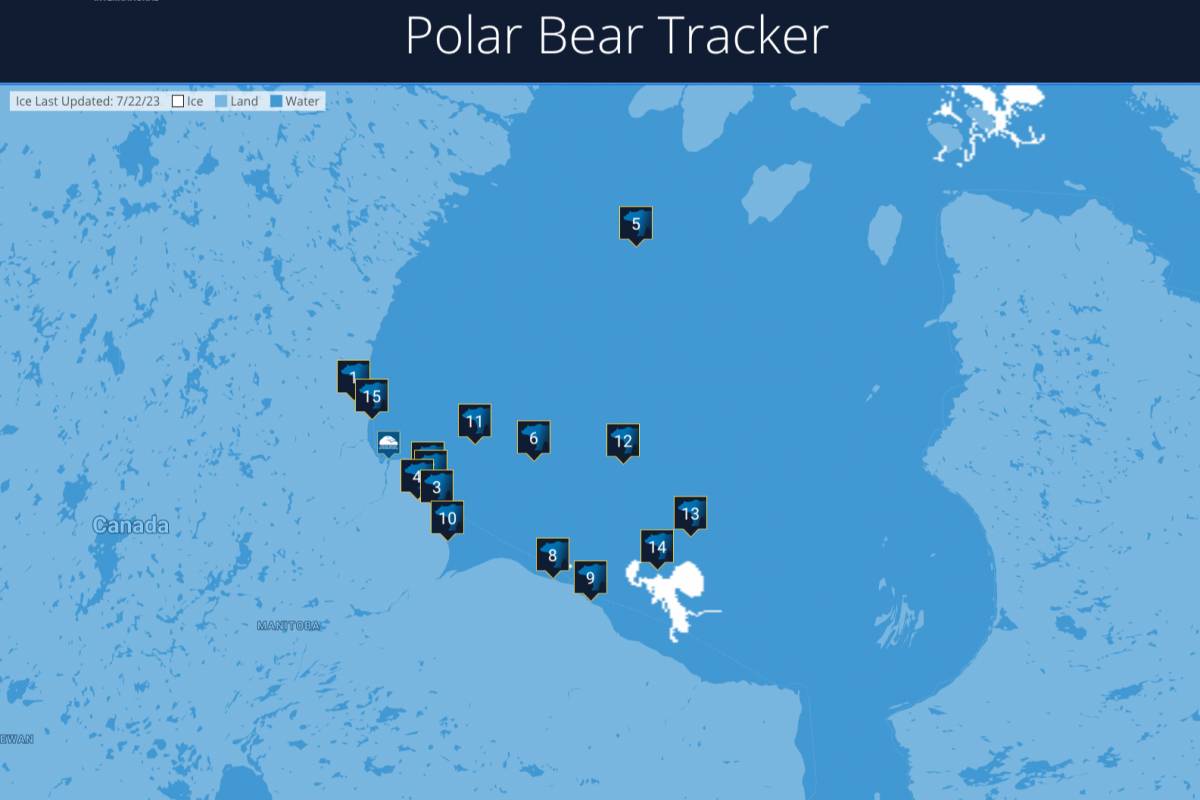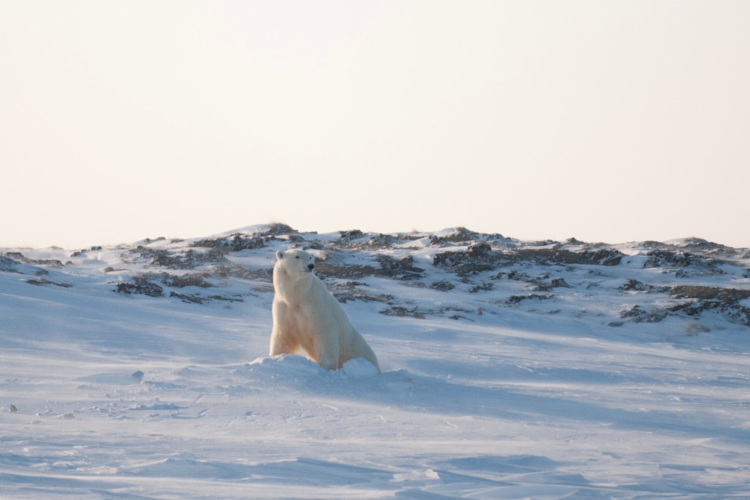Summertime means cool drinks, slathered sunscreen, funky beach towels … and Hudson Bay polar bears returning to shore.
Each year, Polar Bears International works with researchers to track select collared female polar bears from the Western and Southern Hudson Bay populations on our Bear Tracker. We follow the bears year round and have the chance to examine their strategies as they return to firm ground during the summer sea ice melt period.
Meltdown Mode
Hudson Bay is in the midst of its annual breakup season, meaning its sea ice is melting and the ice-free season is starting. The ice will freeze again later this November or December, but until then the local polar bears are being forced onto shore away from their main prey, seals. This is a regular pattern in the Seasonal Sea Ice Ecoregion, but these days the timing of break up and freeze-up is becoming more and more irregular, with consequences for polar bears and other sea ice-dependent species.
Sea ice break up in Hudson Bay is already three to four weeks earlier compared to the 1980s. This year, it looks like the breakup happened around June 17th when, historically, it was closer to July 15th (when we celebrate Arctic Sea Ice Day). Each extra day on land means ~1 kg of body fat burned for polar bears and each little bit counts: these bears now face many months of fasting until the bay refreezes. Hopefully the bears come back to land as fat as possible and this fall’s freeze-up happens on time to give them the best chance at staying healthy (especially those females trying to give birth this winter!).
As these polar bears find a good place to hunker down, stay safe, and rest through the next few months, we will take a short hiatus on the Bear Tracker while continuing to watch the sea ice conditions across the Arctic. Average Arctic sea ice extent during June 2023 was the 13th lowest June in the satellite record at 800,000 square kilometers (309,000 square miles; an area larger than Texas) below the 1981 to 2010 average.
Polar Bears International will announce the annual Arctic sea ice minimum (the lowest ice coverage of the year) in September and what it means for polar bears. Then, in the fall we will start following new polar bears on the Tracker as they gather along the coast to wait for the ice to freeze. We will be there too, to live stream and narrate the incredible activity and highlight our love of the bears. In the meantime, please check out ways you can join global efforts to support the species by checking out our Advocacy Toolkit and joining our mailing list. Thank you for your support!
Sponsored Bear Updates
1. Anuri - X19827, Polar Bears InternationaI’s Storytelling Bear
Twenty-three year old Anuri and her yearling made it to land on June 28th after traveling over 2535 km. This little family stayed solidly in the western region of Hudson Bay the entire year, never going much farther south than Churchill, instead preferring to do some far-north tours in search of seals. Now ashore in Nunavut, we will see whether this family will travel down to Wapusk National Park in the coming weeks. Females in this region tend to exhibit “site fidelity,” meaning they return to the same region each summer. Anuri’s yearling has less than a year left with mom so it will have to learn lots in a short period of time. But, they have many lazy days ahead to spend together while they conserve their energy until the ice returns. Hopefully they came back to land fat and full!
2. Arctic Ambassador Bear - X33203, Arctic Ambassador Centers
The 19-year-old AAC bear is now on her own after weaning her cubs this past spring. She would have likely mated on the ice in the last couple months and, if she’s healthy enough, may become pregnant over the summer and enter a den this fall. If she has enough body fat to sustain the pregnancy she won't return to the ice until March next year, meaning she has a very long fast ahead - about 8 months. Overall, our AAC bear traveled over 1779 km this year, staying in the northwest portion of Hudson Bay almost the entire time and returning to land very close to where she left it last fall. We hope her offspring (now subadults!) are doing well and have learned to navigate their way back to shore alone for the first time. Best wishes to the AAC bear and, hopefully, her new litter next spring!
3. Betty White - X33570, explore.org
Eleven-year-old Betty White has traveled over 2081 km with her yearling cub. She is another bear that has stayed in the northwest portion of Hudson Bay throughout the year, and has a relatively smaller home range (though she moves a lot within it). Her last collar update showed her on June 28th far out in the bay, meaning she may have quite a bit of swimming ahead of her to get to land. Luckily her cub is a bit older and can hopefully keep up. It is normal for collars to go offline during this ice melt season as they get exposed to cold water and salt; usually they’ll come back online after they dry out on land a while. Betty White and yearling have less than a year left together—we are sure mom will make the most of it and teach her cub everything she knows about navigating sea ice and hunting seals.
4. Portia - X33829, Natural Exposures
Seven-year-old Portia and her yearling remain some of the biggest travelers on our map, clocking in at over 2735 km so far. This little family swooped all around the western portion of Hudson Bay this past year, heading fairly far north and far south at different times, likely in search of the best hunting grounds. Now that we enter the ice-free season, Portia’s last collar update was on June 28th off the coast of Wapusk National Park, meaning she may have some swimming ahead of her to get back to land. Luckily she has a yearling which should be old enough to keep up with mom in the water. It is normal for collars to go offline during the ice melt season as they get exposed to cold water and salt; usually they’ll come back online after they dry out on land. Portia and yearling have less than a year left together—we are sure mom will make the most of it and teach her cub everything she knows about navigating the frozen ocean and finding food.
5. Talini - X33565 - Canada Goose
Eleven-year-old Talini and her two yearlings made it back to shore around June 29th, coming back to almost exactly where they left last November at Cape Churchill. This little family made some big moves this past year, traveling over 2159 km throughout the western half of Hudson Bay. Having two yearlings to feed may be extra work, but hopefully as the cubs get older they’re able to better help their mom hunt and haul seals up from the ocean. Six front paws are better than two! Facing the long months of fasting ahead, this family will likely find a nice place to rest this summer and conserve their energy. The yearlings have less than a year left with mom so will have lots left to learn in a short time. We wish them a slow-moving summer and fast ice freeze-up.
6. Vicky- X17666, VICKS/WICK
Vicky is still a major mover! She and her yearling moved farther north than most bears we tracked this year, and as of late May were still out in northern Hudson Bay. Her collar may be a bit waterlogged right now, which is normal during the breakup season; it will likely come back online once Vicky makes it back to shore and has some time to dry off. So far this little family has traveled over 2107 km throughout the year, and no doubt will rack up more kms as they head back to shore. Though they’re far away now, they should return to somewhere near Wapusk National Park, as most females in this population do. Vicky has less than a year left to teach her yearling everything she knows about being a polar bear—good luck to them both!
15. Yvette - X17402, Frontiers North Adventures
Yvette is still by far one of the biggest travelers on the Tracker, racking up over 3117 km over the past year. Along with her now-yearling, Yvette has been up and down and all around Hudson Bay’s western half, recently returning to land around June 29th in Nunavut. This is another bear who returned to land almost exactly where she left it last November, clearly knowing what area works for her. It’s likely this family will keep heading south, closer to Wapusk National Park, over the next couple months to rest and fast until the sea ice refreezes this fall. Her yearling has less than a year left with mom so needs to pack in as many lessons as possible!

















